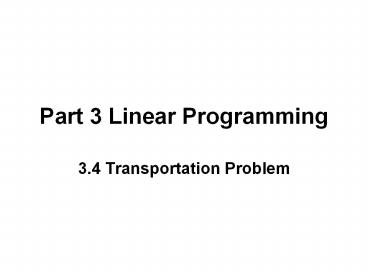Part 3 Linear Programming - PowerPoint PPT Presentation
1 / 37
Title:
Part 3 Linear Programming
Description:
Part 3 Linear Programming 3.4 Transportation Problem The Transportation Model Theorem A transportation problem always has a solution, but there is exactly one ... – PowerPoint PPT presentation
Number of Views:54
Avg rating:3.0/5.0
Title: Part 3 Linear Programming
1
Part 3 Linear Programming
- 3.4 Transportation Problem
2
(No Transcript)
3
The Transportation Model
4
Theorem
- A transportation problem always has a solution,
but there is exactly one redundant equality
constraint. When any one of the equality
constraints is dropped, the remaining system of
nm-1 equality constraints is linearly
independent.
5
Constraint Structure
6
Problem Structure
7
Model Parameters
8
Transformation of Standard Form of Transportation
Problem into the Primal Form
9
Asymmetric Form of Duality
10
Dual Transportation Problem
11
Interpretation of the Dual Transportation Problem
- Let us imagine an entrepreneur who, feeling that
he can ship more efficiently, come to the
manufacturer with the offer to buy his product at
origins and sell it at the destinations. The
entrepreneur must pay -u1, -u2, , -um for the
product at the m origins and then receive v1, v2,
, vn at the n destinations. To be competitive
with the usual transportation modes, his prices
must satisfy uivjltcij for all ij, since uivj
represents the net amount the manufacturer must
pay to sell a unit of product at origin i and but
it back again at the destination j.
12
Example
Amount Available a17 a210 a312
D1 D2 D3
D4
12 x11 3 x12 8 x13 4 x14
7 x21 4 x22 6 x23 9 x24
8 x31 7 x32 3 x33 6 x34
O1 O2 O3 Amount required
b14 b28 b311
b46
13
(No Transcript)
14
Solution Procedure
- Step 1 Set up the solution table.
- Step 2 Northwest Corner Rule when a cell is
selected for assignment, the maximum possible
value must be assigned in order to have a basic
feasible solution for the primal problem.
15
Northwest Corner Rule
12 4 3 3 8 4
7 4 5 6 5 9
8 7 3 6 6 6
7 10 12
4 8 11
6
16
Triangular Matrix
- Definition A nonsingular square matrix M is said
to be triangular if by a permutation of its rows
and columns it can be put in the form of a lower
triangular matrix. - Clearly a nonsingular lower triangular matrix is
triangular according to the above definition. A
nonsingular upper triangular matrix is also
triangular, since by reversing the order of its
rows and columns it becomes lower triangular.
17
How to determine if a given matrix is triangular?
- Find a row with exactly one nonzero entry.
- Form a submatrix of the matrix used in Step 1 by
crossing out the row found in Step 1 and the
column corresponding to the nonzero entry in that
row. Return to step 1 with this submatrix. - If this procedure can be continued until all rows
have been eliminated, then the matrix is
triangular.
18
The importance of triangularity is the associated
method of back substitution in solving
19
Basis Triangularity
- Basis Triangularity Theorem Every basis of the
transportation problem is triangular.
20
(No Transcript)
21
Step 3 Find a basic feasible solution of the
dual problem initial guess
Due to one of the constraints in the primal
problem is redundant!
22
Step 3
v112 v23
v35 v48
12 12 4 3 3 3 5 8 OK 8 4 VIOLATION
13 7 VIOLATION 4 4 5 6 6 5 9 9 OK
10 8 VIOLATION 1 7 OK 3 3 6 6 6 6
u1 0 u2 1 u3 -2
7 10 12
4 8 11
6
23
Cycle of Change
a1 a2 a3
v1 v2
v3 v4
-1 c11 x11 1 c12 x12 c13 0 c14 0
1 c21 0 -1 c22 x22 c23 x23 c24 0
c31 0 c32 0 c33 x33 c34 x34
u1 u2 u3
b1 b2
b3 b4
24
Selection of the New Basic Variable
25
Step 4 Find a basic feasible solution of the
dual problem Loop identification
26
Step 4 Move 4 unit around loop 1
v16 v23
v35 v48
6 12 0 3 3 7 5 8 0 8 4 0
7 7 4 4 4 1 6 6 5 9 9 0
4 8 0 1 7 0 3 3 6 6 6 6
u1 0 u2 1 u3 -2
7 10 12
4 8 11
6
27
Repeat Step 3
Violation Cell 14
28
Repeat Step 4 Move 5 unit around the loop
v16 v23
v31 v44
6 12 0 3 3 2 5 8 0 8 4 5
7 7 4 4 4 6 6 6 0 9 9 0
4 8 0 1 7 0 3 3 11 6 6 1
7 10 12
u1 0 u2 1 u3 2
4 8 11
6
NO VIOLATION!!!
29
Solution
30
Application Minimum Utility Consumption Rates
and Pinch Points
- Cerda, J., and Westerberg, A. W., Synthesizing
Heat Exchanger Networks Having Restricted
Stream/Stream Matches Using Transportation
Formulation, Chemical Engineering Science, 38,
10, pp. 1723 1740 (1983).
31
Example - Given Data
32
Temperature Partition
33
Definitions
34
Transportation Formulation
35
Cost Coefficients
36
Additional Constraints
37
Solution































